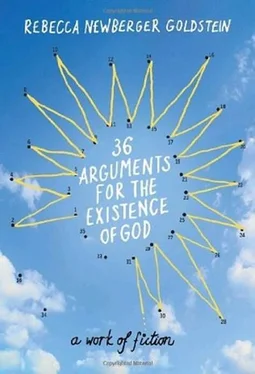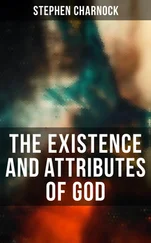APPENDIX: 36 ARGUMENTS FOR THE EXISTENCE OF GOD
1. The Cosmological Argument
Everything that exists must have a cause.
The universe must have a cause (from 1).
Nothing can be the cause of itself.
The universe cannot be the cause of itself (from 3).
Something outside the universe must have caused the universe (from 2 and 4).
God is the only thing that is outside of the universe.
God caused the universe (from 5 and 6).
God exists.
FLAW I CAN BE CRUDELY PUT: Who caused God? The Cosmological Argument is a prime example of the Fallacy of Passing the Buck: invoking God to solve some problem, but then leaving unanswered that very same problem about God himself. The proponent of The Cosmological Argument must admit a contradiction to either his first premise-and say that, though God exists, he doesn’t have a cause-or else a contradiction to his third premise-and say that God is self-caused. Either way, the theist is saying that his premises have at least one exception, but is not explaining why God must be the unique exception, otherwise than asserting his unique mystery (the Fallacy of Using One Mystery to Explain Another). Once you admit of exceptions, you can ask why the universe itself, which is also unique, can’t be the exception. The universe itself can either exist without a cause, or else can be self-caused. Since the buck has to stop somewhere, why not with the universe?
FLAW 2: The notion of “cause” is by no means clear, but our best definition is a relation that holds between events that are connected by physical laws. Knocking the vase off the table caused it to crash to the floor; smoking three packs a day caused his lung cancer. To apply this concept to the universe itself is to misuse the concept of cause, extending it into a realm in which we have no idea how to use it. This line of reasoning, based on the unjustified demands we make on the concept of cause, was developed by David Hume.
COMMENT: The Cosmological Argument, like The Argument from the Big Bang and The Argument from the Intelligibility of the Universe, is an expression of our cosmic befuddlement at the question, why is there something rather than nothing? The late philosopher Sidney Mor-genbesser had a classic response to this question: “And if there were nothing? You’d still be complaining!”
2. The Ontological Argument
Nothing greater than God can be conceived (this is stipulated as part of the definition of “God”).
It is greater to exist than not to exist.
If we conceive of God as not existing, then we can conceive of something greater than God (from 2).
To conceive of God as not existing is not to conceive of God (from 1 and 3).
It is inconceivable that God not exist (from 4).
God exists.
This argument, first articulated by Saint Anselm (1033-1109), the Archbishop of Canterbury, is unlike any other, proceeding purely on the conceptual level. Everyone agrees that the mere existence of a concept does not entail that there are examples of that concept; after all, we can know what a unicorn is and at the same time say, “Unicorns don’t exist.” The claim of The Ontological Argument is that the concept of God is the one exception to this generalization. The very concept of God, when defined correctly, entails that there is something that satisfies that concept. Although most people suspect that there is something wrong with this argument, it’s not so easy to figure out what it is.
FLAW: It was Immanuel Kant who pinpointed the fallacy in The Ontological Argument-it is to treat “existence” as a property, like “being fat” or “having ten fingers.” The Ontological Argument relies on a bit of wordplay, assuming that “existence” is just another property, but logically it is completely different. If you really could treat “existence” as just part of the definition of the concept of God, then you could just as easily build it into the definition of any other concept. We could, with the wave of our verbal magic wand, define a trunicorn as “a horse that (a) has a single horn on its head, and (b) exists.” So, if you think about a trunicorn, you’re thinking about something that must, by definition, exist; therefore, trunicorns exist. This is clearly absurd: we could use this line of reasoning to prove that any figment of our imagination exists.
COMMENT: Once again, Sidney Morgenbesser offered a pertinent remark, in the form of The Ontological Argument for God’s Non-Existence: Existence is such a lousy thing, how could God go and do it?
3. The Argument from Design
A. The Classical Teleological Argument
Whenever there are things that cohere only because of a purpose or function (for example, all the complicated parts of a watch that allow it to keep time), we know that they had a designer who designed them with the function in mind; they are too improbable to have arisen by random physical processes. (A hurricane blowing through a hardware store could not assemble a watch.)
Organs of living things, such as the eye and the heart, cohere only because they have a function (for example, the eye has a cornea, lens, retina, iris, eyelids, and so on, which are found in the same organ only because together they make it possible for the animal to see).
These organs must have a designer who designed them with their function in mind: just as a watch implies a watchmaker, an eye implies an eye-maker (from 1 and 2).
These things have not had a human designer.
Therefore, these things must have had a non-human designer (from 3 and 4).
God is the non-human designer (from 5).
God exists.
FLAW: Darwin showed how the process of replication could give rise to the illusion of design without the foresight of an actual designer. Replicators make copies of themselves, which make copies of themselves, and so on, giving rise to an exponential number of descendants. In any finite environment, the replicators must compete for the energy and materials necessary for replication. Since no copying process is perfect, errors will eventually crop up, and any error that causes a replicator to reproduce more efficiently than its competitors will result in the predominance of that line of replicators in the population. After many generations, the dominant replicators will appear to have been designed for effective replication, whereas all they have done is accumulate the copying errors, which in the past did lead to effective replication. The fallacy in the argument, then, is Premise 1 (and, as a consequence, Premise 3, which depends on it): parts of a complex object serving a complex function do not, in fact, require a designer.
In the twenty-first century, creationists have tried to revive the Teleo-logical Argument in three forms:
B. The Argument from Irreducible Complexity
Evolution has no foresight, and every incremental step must be an improvement over the preceding one, allowing the organism to survive and reproduce better than its competitors.
In many complex organs, the removal or modification of any part would destroy the functional whole. Examples are the lens and retina of the eye, the molecular components of blood clotting, and the molecular motor powering the cell’s flagellum. Call these organs “irreducibly complex.”
These organs could not have been useful to the organisms that possessed them in any simpler forms (from 2).
The theory of natural selection cannot explain these irreducibly complex systems (from 1 and 3).
Natural selection is the only way out of the conclusions of The Classical Teleological Argument.
God exists (from 4 and 5 and The Classical Teleological Argument).
Читать дальше












